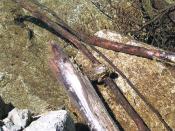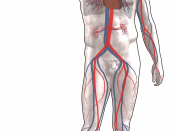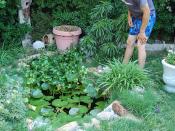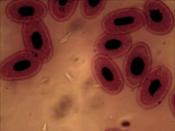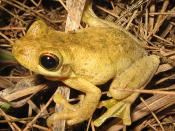FROG'S DIGESTION SYSTEM Frogs have a mouth, which serves as an insect trap. The mouth, consist of a tongue and two sets of special teeth. The frog has a large elastic gullet that allows it to swallow large prey. Food passes from the gullet through the tubular esophagus and then into the stomach. Then chemical digestion occurs in the stomach and the small intestine with the help of the digestive enzymes that are released by the liver and pancreas.
(Giffard, R. & Nat, M 1986.) After digestion is completed nutrients are absorbed into the blood through the walls of the small intestines. The waste left over is moved into the large intestine where water is reabsorbed. Then the waste is eliminated through the cloaca and the anus. (Cooper, H, Hays, S, Walker. D, Linden R 1982) The frog has three lobed livers. The functions of the liver, is to release digestive enzymes to help the stomach and the small intestine with mechanical digestion.
The gall bladder stores bile, which breaks down the partially digested foods that, enters the small intestine. Bile has no enzymes but still manages to break down fat into tiny droplets that are ready for faster chemical breakdown. The frog's stomach is not as complex as a herbivore's because they have to break down cellulose, which takes a longer time. (Giffard R. & Nat, M 1986) This concludes my study on the digestion system of the frog.
FROG'S CIRCULATORY SYSTEM A frog has a closed circulatory system just like humans. This means blood is always enclosed in blood vessels as it circulates the organisms body. Blood also circulates more rapidly and efficiently through a closed circulatory system. It consists of a very well developed system of arteries, veins and capillaries that reach all the living cells of an organism. (Cooper, H., Hays, S., Walker D., Linden R. 1982) The frog's heart consists of three chambers. The left atrium receives "oxygenated" oxygen rich blood from the lungs, while the right atrium receives "deoxygenated" oxygen poor blood, which returns from the body tissues. As the two atria pump, together blood from each atrium, it forces into a muscular ventricle. When the ventricle contracts, it forces blood through a major artery called the truncus arteriosus This is a vessel that divides into a number of smaller arteries which supply blood to all parts of the body.
The actual exchange of gases, nutrients, and waste takes place in the capillaries. Once the exchange of material has taken place, the blood flows back through a series of veins to the heart. While they carry blood back to the heart, the veins merge to form larger and larger vessels. Deoxygenated venous blood goes into the right atrium. While this goes on, oxygenated blood from the lungs is carried to the left atrium by the pulmonary veins. Both the left and the right atria contract at the same time. This forces the blood into the muscular ventricle. Valves are present which prevent the blood from flowing in the wrong direction. After this process the blood begins with the next contraction of the ventricle. (Andrews, et al. 1983) FROG'S GAS EXCHANGE During different stages of a frog's life gases are exchanged through different organs. The frog might use external gills (tadpole stages), the mouth and skin when it is a time of inactivity, such as sleeping. The lungs are used when there is activity, for example when the frog is moving or jumping around. (Griffin, B. & Vania, R. 1990) For the exchange of gases, air is brought in through the nostrils into the nasal cavity. In the nasal cavity the air is heated humidified and cleaned. Then the air is conducted to the pharynx through the larynx and trachea and then into a complex system of tubes which, are called bronchi. These tubes continue to branch, decreasing their size to form ducts called bronchioles. At the end of the bronchioles are sac-like lungs that are surrounded by blood vessels. (Cooper, H., Hays. S., Walker.D Linden R. 1982) Frogs have a single body cavity that contains the lungs and the viscera. Its vertebral bones are not attached to any ribs. Even with this, the frog can still pump air into and out of its lungs. (Bohensky, F. 1987) The frog has four stages of breathing, Inhalation and Exhalation make up the four. In the Inhalation, first air enters the mouth then, the mouths bottom drops, opening of the external nares occurs, the glottis is closed and then the body wall is relaxed. The second stage is inhalation again where first, air enters the lungs and the, mouths bottom is raised then external nares close, the glottis is opened and last the body wall is relaxed. The third stage is where air leaves the lungs, then the mouth lowers, external nares close, the, glottis is open, and last the body wall contracts. The last stage is when air leaves the mouth and it ends with the body wall being relaxed. (Bohensky, F. 1987) This concludes my study on gas-exchange in the frog.
